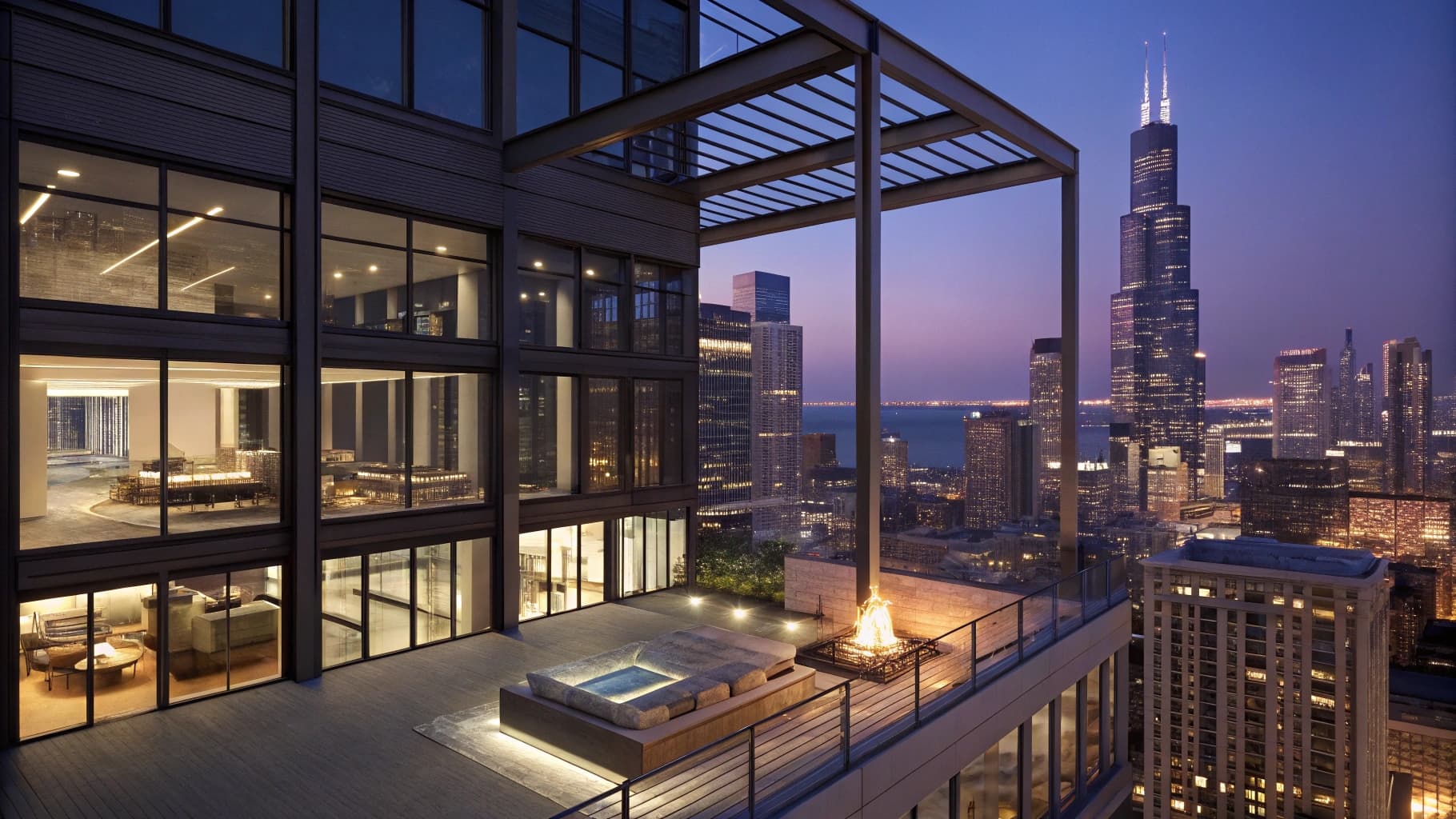Penthouse architecture has long been synonymous with luxury, exclusivity, and breathtaking views. As I delve into this fascinating realm, I find myself captivated by the unique design elements that distinguish penthouses from traditional apartments. These elevated living spaces often occupy the top floors of high-rise buildings, offering not only panoramic vistas but also a sense of privacy that is hard to replicate.
The architectural style of penthouses can vary widely, from sleek modern designs featuring glass facades to more traditional layouts that incorporate classic materials like brick and stone. Each penthouse tells a story, reflecting the tastes and lifestyles of its inhabitants while also responding to the urban environment in which it resides. The allure of penthouse living extends beyond mere aesthetics; it embodies a lifestyle choice that many aspire to.
As I explore various penthouse designs, I notice how they often serve as a canvas for architects and designers to push the boundaries of creativity. The open floor plans, expansive terraces, and innovative use of space are just a few characteristics that make penthouses stand out. Moreover, the integration of outdoor spaces, such as rooftop gardens and private pools, enhances the living experience, allowing residents to enjoy nature amidst the urban hustle.
In this article, I will examine the evolving trends in penthouse architecture, focusing on sustainable design, technological integration, and the impact of urbanization.
Sustainable Design and Green Initiatives
As I reflect on the future of penthouse architecture, I am increasingly drawn to the importance of sustainable design and green initiatives. In recent years, there has been a significant shift towards eco-friendly building practices, and penthouses are no exception. Many architects are now prioritizing sustainability by incorporating energy-efficient systems, using renewable materials, and designing for minimal environmental impact.
This commitment to green living not only benefits the planet but also enhances the quality of life for residents. I find it inspiring to see how penthouses can be designed to harness natural light, utilize rainwater harvesting systems, and feature green roofs that contribute to urban biodiversity. The integration of sustainable practices in penthouse design is not merely a trend; it reflects a growing awareness of our responsibility towards the environment.
As I explore various projects, I am impressed by how architects are creatively addressing challenges such as energy consumption and waste management. For instance, some penthouses now feature solar panels that generate electricity, while others incorporate smart home technologies that optimize energy use. These innovations not only reduce the carbon footprint of these luxurious spaces but also appeal to environmentally conscious buyers who seek a lifestyle that aligns with their values.
The marriage of luxury and sustainability in penthouse architecture is a testament to how we can enjoy modern living while being stewards of the earth.
Integration of Technology in Penthouse Living
In my exploration of penthouse architecture, I cannot overlook the profound impact of technology on modern living spaces. The integration of smart home technologies has revolutionized how we interact with our homes, making life more convenient and efficient. From automated lighting systems to advanced security features, technology has become an essential component of penthouse design.
As I navigate through various penthouses, I am often amazed by the seamless incorporation of these technologies into the overall aesthetic. Touchscreen controls and voice-activated systems blend effortlessly with luxurious finishes, creating an environment that is both sophisticated and functional. Moreover, technology enhances not only convenience but also connectivity.
In today’s fast-paced world, being able to control various aspects of my living space from my smartphone or tablet is incredibly appealing. Whether it’s adjusting the thermostat while I’m away or monitoring security cameras in real-time, these technological advancements provide peace of mind and ease of use. Additionally, many penthouses now feature integrated entertainment systems that allow for immersive experiences, whether I’m hosting a gathering or enjoying a quiet evening at home.
The fusion of technology and design in penthouse architecture is a reflection of our evolving lifestyles and the desire for spaces that cater to our needs.
The Rise of Multi-Level Penthouse Living
As I delve deeper into the world of penthouses, I am intrigued by the rise of multi-level living spaces. This trend has gained momentum in recent years as architects seek to maximize space while providing unique living experiences. Multi-level penthouses often feature expansive layouts that include multiple floors connected by elegant staircases or private elevators.
This design approach not only enhances the sense of luxury but also allows for distinct areas within the home—such as separate entertainment zones, private retreats, or even home offices—catering to diverse lifestyles. The allure of multi-level penthouses lies in their ability to create a sense of grandeur while maintaining intimacy. As I explore these spaces, I appreciate how they can be tailored to suit individual preferences.
For instance, some residents may choose to dedicate an entire floor to leisure activities, complete with a home theater or gym, while others may prefer a more serene atmosphere with private bedrooms and study areas. This flexibility in design allows for personalization that is often lacking in traditional single-level apartments. The rise of multi-level penthouse living reflects a broader trend towards creating homes that are not only luxurious but also functional and adaptable to the needs of modern life.
The Influence of Urbanization on Penthouse Architecture
Urbanization has significantly shaped the landscape of penthouse architecture, as cities continue to grow and evolve. As I observe this phenomenon, it becomes clear that penthouses are often designed with urban living in mind—maximizing views while minimizing space constraints. The demand for housing in densely populated areas has led architects to innovate and create vertical living solutions that cater to an increasingly urban population.
Penthouses have become symbols of status in these bustling environments, offering residents a unique vantage point from which to experience city life. The influence of urbanization extends beyond mere aesthetics; it also impacts how penthouses are integrated into their surroundings. Many modern penthouses are designed with an emphasis on community engagement and connectivity to urban amenities.
As I explore various developments, I notice how architects are incorporating features such as communal terraces or rooftop gardens that encourage social interaction among residents. This focus on creating vibrant communities within high-rise buildings reflects a growing recognition that urban living should not only be about individual luxury but also about fostering connections with others in the city.
Customization and Personalization in Penthouse Design
One of the most exciting aspects of penthouse architecture is the opportunity for customization and personalization. As I navigate through various designs, I am struck by how these spaces can be tailored to reflect the unique tastes and lifestyles of their inhabitants. From selecting finishes and materials to designing custom layouts, residents often have a significant say in how their penthouses come together.
This level of personalization transforms a house into a home, allowing individuals to express their identity through their living spaces. The trend towards customization is not limited to aesthetics; it also encompasses functionality. Many architects now offer flexible design options that allow residents to adapt their spaces according to their needs over time.
For instance, an open-concept layout can be modified with movable partitions to create distinct areas for work or leisure as life circumstances change. This adaptability is particularly appealing in today’s fast-paced world where priorities can shift rapidly. As I explore these customizable designs, I am reminded that penthouses are not just luxurious retreats; they are dynamic spaces that evolve alongside their residents.
Community and Social Spaces in Penthouse Developments
While penthouses are often associated with exclusivity and privacy, there is a growing trend towards incorporating community and social spaces within these developments. As I examine various projects, I am encouraged by how architects are recognizing the importance of fostering connections among residents. Many modern penthouse buildings now feature shared amenities such as lounges, fitness centers, and rooftop gardens that encourage social interaction and collaboration among neighbors.
These communal spaces serve as extensions of individual homes, providing opportunities for residents to engage with one another while enjoying shared experiences. As I envision myself in these environments, I appreciate how they promote a sense of belonging within high-rise living. Whether it’s hosting a gathering on a shared terrace or participating in community events organized by building management, these social spaces enhance the overall living experience in penthouses.
The integration of community-focused design reflects a broader understanding that even in luxurious settings, human connection remains essential.
The Impact of Global Trends on Penthouse Architecture
As I reflect on the evolution of penthouse architecture, it becomes evident that global trends play a significant role in shaping design choices and preferences. The influence of international styles can be seen in contemporary penthouses that draw inspiration from diverse cultures and architectural movements. For instance, minimalist designs inspired by Scandinavian aesthetics emphasize simplicity and functionality, while Mediterranean influences may introduce warm colors and natural materials.
Moreover, global trends extend beyond aesthetics; they also encompass lifestyle choices that impact how we live in our homes. The rise of remote work has led many individuals to seek out spaces that accommodate both professional and personal needs within their homes. As I explore various penthouse designs, I notice how architects are responding to this shift by creating dedicated workspaces or flexible areas that can easily transition from office to leisure space.
This adaptability reflects a broader understanding of how our lifestyles are changing in response to global events. In conclusion, my exploration of penthouse architecture reveals a dynamic interplay between luxury living and contemporary design trends. From sustainable practices to technological integration and community-focused spaces, penthouses are evolving into multifaceted environments that cater to diverse lifestyles while embracing innovation.
As urbanization continues to shape our cities and global influences permeate our lives, I am excited to see how penthouse architecture will continue to adapt and inspire future generations.
FAQs
What is penthouse architecture?
Penthouse architecture refers to the design and construction of luxury residential spaces located on the top floor of a building, typically offering panoramic views and exclusive amenities.
What are some trends in penthouse architecture?
Some current trends in penthouse architecture include the use of sustainable and eco-friendly materials, integration of smart home technology, and the incorporation of outdoor spaces such as rooftop gardens and terraces.
How is penthouse architecture evolving in the future?
The future of penthouse architecture is likely to see an increased focus on sustainable and energy-efficient design, as well as the integration of advanced technology for security, comfort, and convenience. There may also be a greater emphasis on creating seamless indoor-outdoor living experiences.
What are some key considerations in designing a penthouse?
Key considerations in designing a penthouse include maximizing natural light and views, creating functional and flexible living spaces, and incorporating high-end finishes and amenities to cater to the luxury market.
What are some challenges in penthouse architecture?
Challenges in penthouse architecture may include structural limitations, such as weight restrictions and building codes, as well as the need to create a sense of privacy and exclusivity while still maintaining a connection to the surrounding urban environment.

